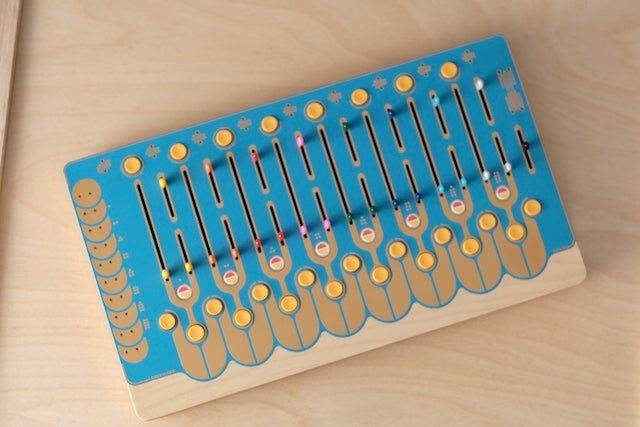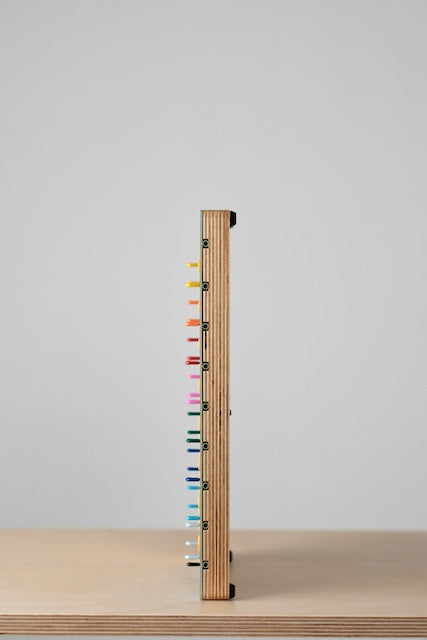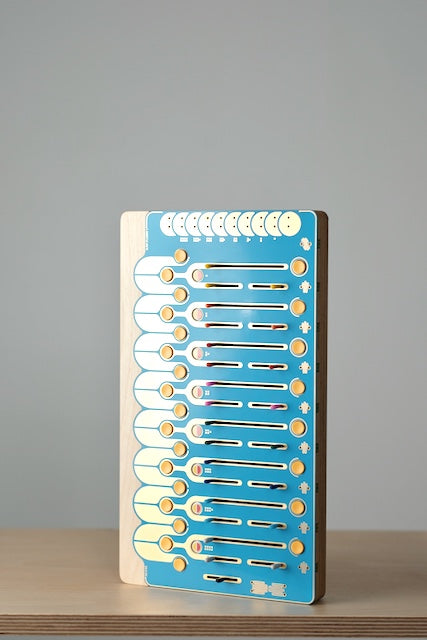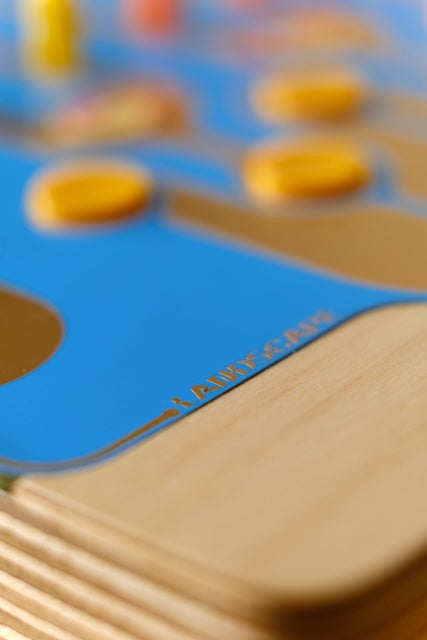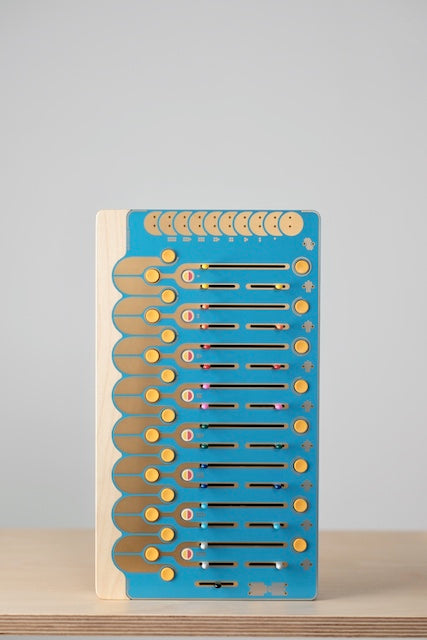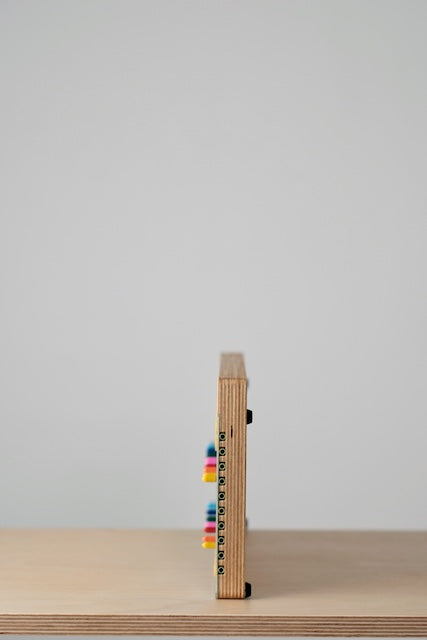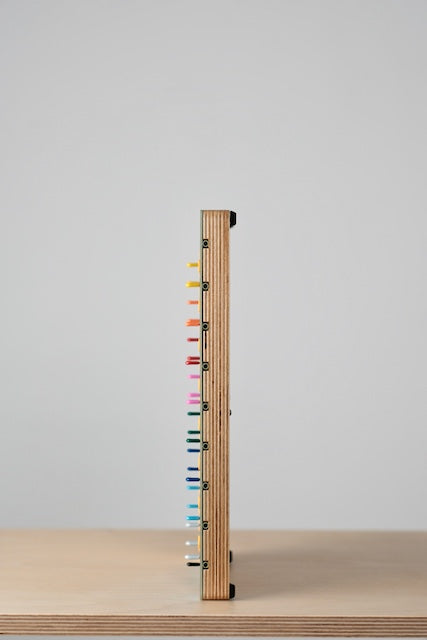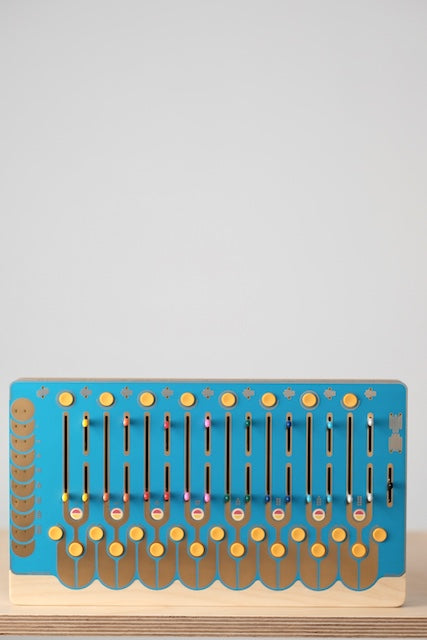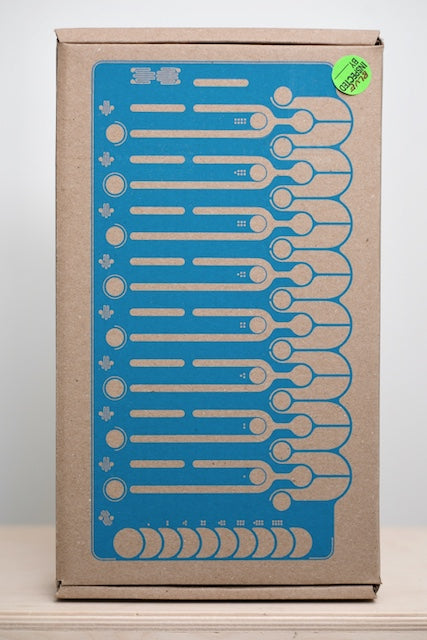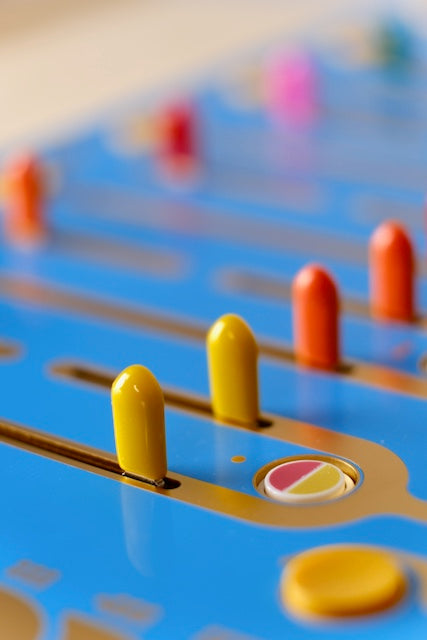Landscape
Landscape Noon Passive Analog drum/synthesizer BLUE
Landscape Noon Passive Analog drum/synthesizer BLUE
Brand new. Authorized dealer.
From the manufacturer:
Overview✺
-
WHO❀ Noon
-
WHAT❈ An 8 channel powerless instrument which is activated and modulated using voltage from external sequencers.
-
HOW✷ Analog circuits are powered momentarily by incoming gate and control voltage signals causing them to oscillate and breathe naturally. When these circuits are linked together they can grow, inform and process one another in complex rhythmic ways.
-
WHY❃ This technique increases the unstable properties of analog circuits, causing increased organic textures and movement. The simple controls are provided to ensure immediacy and access to rapidly alter sounds and movement without patching.
-
WHERE✾ The simplicity of the interface was designed with live performance in mind. The number of internal and external variables (control voltage types, linked channel behavior plus external audio input) create lots of room for studio exploration.
-
WHEN✻ Now
IN-DEPTH✹
NOON is a passive analog drum/synthesizer. Each of the eight channels uses a unique analog circuit with its own characteristics. No power supply is needed. Each circuit is triggered and powered individually from incoming gates or control voltages provided by voltage sequencers or modular systems. By using this unique method, we can increase instability and magnify organic aspects of traditional analog electronic instruments. The sound of analog, at its core, is the sound of sculpted electricity. By removing the stabilizing elements of a constant power source, we can listen to the sound of electronic circuits loading and unloading, powering up and powering down, and we can increase the natural chaotic movement of electricity. The loading of circuits creates natural ways to access swing and groove or ways to deconstruct a programmed rhythm sequence to make surprisingly new ideas.
Each channel is represented by a tuning fork. Incoming voltage can be thought of as a way to “strike” each fork with momentary voltage. Between every channel there are Link buttons which allow voltage sharing between channels. Linking them provides a wide mix of results depending on incoming voltage, active or inactive channels, slider settings, gate lengths and multichannel linking. The results can be described as cross modulation, growth (creating a larger and more complex circuit), or processing (filtering, distortion). Due to the cycles of voltage and this inherent instability, a definition of what is actually occurring between channels can be hard to pin down. The eight Mod buttons, which are located at the bottom of each tuning fork, change the behavior and sound of each circuit. The eight latching CV buttons along the top allow the “☾” Even and “❍” Odd CV modulation inputs to route to even and odd channels. When incoming CV is unmuted, a channel’s behavior can change drastically and this behavior can change further when channels are linked. These CV inputs are a way to add microtonal pitch changes and/or large textural movement to voices. The Even and Odd CV inputs are summed to their respective channels to provide a rhythmic modulation reference between multiple channels. ⏚
☁︎Which Sequencers/Control Voltage Sources Work
Each model of voltage sequencer will have different effects on the tonality of the instrument due to differences in power and feature sets between manufacturers. NOTE: The strongest recommendations for Noon are currently the Arturia Beatstep Pro and Eurorack modular systems. This is due to the strength of power provided and quick access to gate/control voltage variations. Noon has shown great results with these sequencers (and voltage source examples) thus far:
-Sequentix Cirklon / Arturia Beatstep Pro & Keystep Pro / Ableton Push 3 / ALM Busy Circuits Pamala’s Workout / Make Noise 0-ctrl / Westlicht Per Former / Motu Ultralight as CV interface / Qu-Bit Contour / Schlappi Engineering Angle Grinder / Music Thing Turing Machine + Pulses mkii / Polyend Poly 2 / Sixty Four Pixels CV.OCD / Social Entropy Engine / Making Sound Machines Stolperbeats / Soma Ornament-8 / Soma Pulsar-23 / Acid Rain Technology Constellation / Five12 Vector Sequencer / Mannequins Just Friends / Mutable Instruments Marbles & Stages / Expert Sleepers ES-9 & FH-2 / OXI One / monome teletype + meadowphysics / Meng Qi Voltage Memory / vpme.de Euclidean Circles v2 / ET Levit8 / MPC One / WMD Metron / Tiptop Audio Trigger Riot / Shakmat Four Bricks Rook / Frap Tools Falistri / Lorre Mill Double Knot / ⌘various audio rate oscillators
☂︎Which Sequencers/Control Voltage Sources Don’t.
Given the very close relationship between Noon and what’s driving it you could experience non-flattering results in some cases. We’ve mostly found that USB powered sequencers (*other than the BSP) provide less power. Please Note: two of these were listed in the working category previously but after some circuit changes and further testing we can’t recommend them without using an external MIDI to CV converter for additional power. Note II: you can still get some good sound out of them!
-Korg SQ-64 (low power, **However, we’ve been told that using a Volca power supply and updating to the newest firmware is a big help)
-Synthstrom Deluge (low power, can activate some voices but not all)
-Torso T-1 (low power, can activate some voices but not all)
*we continue to post more examples of working/non-working relationships as we get access to more equipment and learn of more accounts from users. Thank you for all the suggestions thus far!
Audio☁︎
-
The sound examples below were sequenced/powered using the Arturia Beatstep Pro, unless otherwise noted. Some examples use 12v, 10v and 5v gates.
-
No swing is used in the examples and all pattern examples are quantized.
-
No compression, limiting or effects are applied. Please use caution when listening at louder volumes.
-
The feedback and distortion heard in various examples is not due to a specially designed “distortion effect”, it is the organic results of multichannel linking and the character of the circuits.
-
Below you will find five groupings of multichannel focused examples and eight groupings of single channel focused examples ▼
⌘Features
-
Each channel has dynamic and organic response to different gate lengths. Each channel responds differently to gate lengths due to power loading characteristics of each circuit type.
-
Each channel will respond differently to an assortment of control voltage types. Short envelopes sound very nice and you can even send LFOs or more complex voltages for highly textured results or droning behavior.
-
Each of the 8 channels feature a unique analog circuit which is powered and controlled directly from its gate input.
-
Each channel can be treated as a “drum voice” or a “synth voice” but more likely somewhere in between.
-
Each channel features three slider controls: 1. main pitch/tone/texture 2. secondary pitch/tone/texture 3. volume
-
Each channel has a latching Mod button which changes the sound and response of the channel.
-
Eight CV Mute buttons allowing for muting or unmuting of incoming CV from the Even or Odd CV inputs.
-
Even/Odd CV Inputs are a summed to even and odd channels respectively when CV Mutes are unmuted.
-
Each channel can link to the neighboring channel via a link button. The two link buttons at either end (of channels 1 and 8) allow the channel links to wrap back around, 1 → 8 or 8 → 1
-
All eight Gate Inputs can be powered by control voltages of any kind for widely varying results.
-
Individual audio output per channel. These outputs are DC coupled to allow each channel’s behavior to double as a modulation source for modular synthesizers.
-
Individual volume control per channel.
-
When an individual output is used, the channel will be removed from the main outputs.
-
Main Even & Odd channel audio outputs (AC coupled) with a singular volume control. Even and odd channels are summed to these two outs.
-
The Even Output normals to a mono mix of all 8 channels when no plug is present in the Odd Output.
-
If using the main outputs while Channel Link buttons are engaged, strange stereo-esk imaging can occur because of shared characteristics and cross talk created by modulation and voltage sharing of Even & Odd Channels.
-
The passive mix of the main outputs can create competition between channels resulting in compression effects.
-
When a channel is treated as a “synth voice” incoming CV will not create a volts per octave or a 12 tone response. Instead expect microtonalities and depending on the channel, large shifts in texture from note to note. Each channel will track pitch differently based upon its slider settings. Pitch CV can also be used in the Gate inputs for additional behaviors.
-
When utilizing incoming CV along with gate signals a singular voice can at times achieve the illusion of multiple rhythm elements.
-
Voices can achieve somewhat normal analog rhythm machine sounds when fed short gates or triggers.
-
Varying gate length sequences can achieve movement and textural complexity normally associated with modular instruments and feedback patching.
-
An external Audio Input is activated via the DOT/DUAL link button. This allows the link button to behave as a mute for incoming audio. External audio will mainly feed into the DUAL channel which can behave as a chaotic filter-feedback-distortion-vca type effect. The rhythm and tonality of the effect will vary greatly depending upon what method or methods of voltage you’re sending to DUAL and to a lesser extent DOT.
-
In additional to being processed, the external audio can at times behave as a modulation source due to the additional voltage fluctuations provided by said audio.
-
The Audio Input can be used to feedback any channel into channel 2/Dual.
-
Each of the eight dual color Mute buttons will illuminate when a gate or voltage is received. When active it will illuminate yellow and when muted it will illuminate red. The intensity of illumination will changed based upon how much voltage is being received.
-
The eight Mute buttons are post gate inputs which allow the channel to continue to effect or voltage share with a neighboring channel while they are linked.
-
Eight pairs of 16 Touch Plates. Results will vary based upon incoming voltages, gate duration and control settings. They are designed for fingers to span two at a time for modulation but they can also send modulation between channels through skin when more fingers are utilized. At times touch modulation between channels will also be sending audio content to each other blurring the lines of what you are hearing.
-
One audio touch point per channel and main outs. Touching the main outs will let you listen to the ground hum of your environment. Touching the small individual output points (along the top edge) simultaneously to various touch plates along the bottom edge can at times create modulation or volume changes depending on incoming voltage and control settings.
-
The vertical row of CV/Gate input touch points along the left edge add the possibility to intermingle incoming voltages and rhythms across channel touch plates (results vary based upon incoming voltages and their duration).
-
Active CV inputs can engage drone behavior in some channels, this drone behavior can grow in texture, movement and complexity as Link buttons are engaged. Use CV mute buttons along the top row to turn CV on or off.
-
Interplay between linked channels can vary widely based upon how they are being activated, their slider settings, and at what intervals.
-
When linked, powered channels will sometimes share voltage and thus partially activate unpowered channels. In this way, linking to unpowered channels can provide changes/modulation to the powered channel.
-
Linked channels can be mutually responsive creating movement and modulation between one another or, depending on use, become more than one directional. For example, one voice may simultaneously be acting as an independent drum sound and a bubbling filter, feedback or distortion in the next instance “processing” its neighboring channel. At times the “processing” aspects from one channel will coincide with the modulation of another. In this way the two channels can become intermingled and contain both rhythmic and textural similarities of each other.
-
At their most extreme settings voices can emit pops, clicks and random noise allowing you to sequence sounds normally associated with malfunctioning electronics.
❒Recommendations & LIMITATIONS
-
A voltage sequencer, modular system or some form of external control voltage is required for use. This is a powerless instrument which relies upon receiving voltage and control from external sources.
-
Using sequencers which have the ability to vary gate length is highly encouraged due to the increase in sound possibilities and rhythmic movement.
-
Given the passive design of the device the reaction of the touch plates will vary greatly based upon what voltages are being received in which channel, how many channels are being touched, skin moisture and gate lengths. Using only trig signals can significantly lessen touch plate response.
-
Noon’s volume controls and mixing are done passively which can create situations for non-linear behavior, interaction between channels, audio bleed and at times affect overall chaos during droning patches. To fully mute a channel the mute buttons should be utilized because the individual sliders will still allow some audio through at the lowest setting. Noon’s two dedicated CV inputs are also passively summed to the even and odd channels. This can create cross talk, audio bleed and interaction between even and odd channels when utilized. We take these additional interactions as a feature rather than a limitation but that’s just us :)
-
Sequencers with USB power should be used with a USB wall adaptor because powering via a computer can create background noise in Noon. Sometimes that extra noise sounds nice and sometimes a bit annoying.
-
Channels 7 & 8 (Larynx & Bacid) will give best results being fed gate and cv voltage simultaneously. Sending trigs instead of gates to these channels may have less interesting results than found in other channels.
〄Specifications
-
Dimensions: 32cm x 18cm x 2.5cm / 12.5” x 7” x 1”
-
Materials: Gold plated PCB (2mm fiberglass) / routed Birch plywood case with clear coat / metal shaft sliders with rubber caps / concave and dual LED latching push buttons
-
Weight: 0.9 kg. / 2 lbs.
-
CV Inputs: 10 x 3.5mm jacks
-
Audio Input: 1 x 3.5mm jack
-
Audio Outputs: 10 x 3.5mm jacks
▲ NOON would not have been possible without the electrical engineering wisdom of Eli Pechman of Mystic Circuits ▲
Design help and aural feedback:
Erin VanZandt
Emily Brandt
Ivaylo Gueorgiev
Auditory and visual Influence:
Autechre
Don Buchla
Arca
Serge Tcherepnin
Bogdan Raczynski
Peter Blasser
Georgia Anne Muldrow
Lorre Mill
Aphex Twin
Sean Hellfritsch
Suzanne Ciani
Brian Crabtree
Rolando Simmons
Meng Qi
Björk
Couldn't load pickup availability
Share

